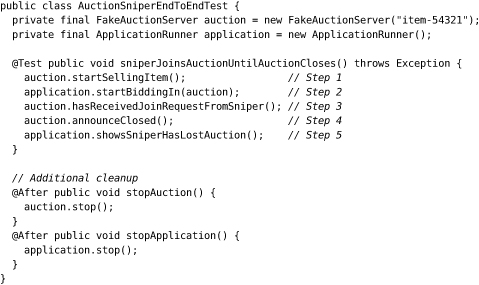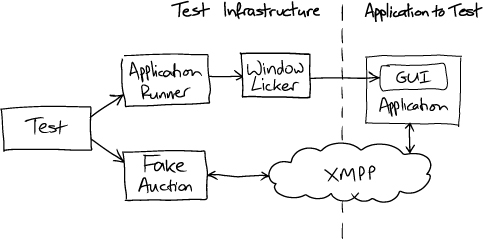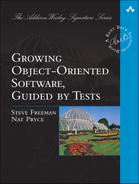Chapter 10. The Walking Skeleton
In which we set up our development environment and write our first end-to-end test. We make some infrastructure choices that allow us to get started, and construct a build. We’re surprised, yet again, at how much effort this takes.
Get the Skeleton out of the Closet
So now we’ve got an idea of what to build, can we get on with it and write our first unit test?
Not yet.
Our first task is to create the “walking skeleton” we described in “First, Test a Walking Skeleton” (page 32). Again, the point of the walking skeleton is to help us understand the requirements well enough to propose and validate a broad-brush system structure. We can always change our minds later, when we learn more, but it’s important to start with something that maps out the landscape of our solution. Also, it’s very important to be able to assess the approach we’ve chosen and to test our decisions so we can make changes with confidence later.
For most projects, developing the walking skeleton takes a surprising amount of effort. First, because deciding what to do will flush out all sorts of questions about the application and its place in the world. Second, because the automation of building, packaging, and deploying into a production-like environment (once we know what that means) will flush out all sorts of technical and organizational questions.
Of course, we start our walking skeleton by writing a test.
Our Very First Test
The walking skeleton must cover all the components of our Auction Sniper system: the user interface, the sniping component, and the communication with an auction server. The thinnest slice we can imagine testing, the first item on our to-do list, is that the Auction Sniper can join an auction and then wait for it to close. This slice is so minimal that we’re not even concerned with sending a bid; we just want to know that the two sides can communicate and that we can test the system from outside (through the client’s GUI and by injecting events as if from the external auction server). Once that’s working, we have a solid base on which to build the rest of the features that the clients want.
We like to start by writing a test as if its implementation already exists, and then filling in whatever is needed to make it work—what Abelson and Sussman call “programming by wishful thinking” [Abelson96]. Working backwards from the test helps us focus on what we want the system to do, instead of getting caught up in the complexity of how we will make it work. So, first we code up a test to describe our intentions as clearly as we can, given the expressive limits of a programming language. Then we build the infrastructure to support the way we want to test the system, instead of writing the tests to fit in with an existing infrastructure. This usually takes a large part of our initial effort because there is so much to get ready. With this infrastructure in place, we can implement the feature and make the test pass.
An outline of the test we want is:
1. When an auction is selling an item,
2. And an Auction Sniper has started to bid in that auction,
3. Then the auction will receive a Join request from the Auction Sniper.
4. When an auction announces that it is Closed,
5. Then the Auction Sniper will show that it lost the auction.
This describes one transition in the state machine (see Figure 10.1).
Figure 10.1 A Sniper joins, then loses

We need to translate this into something executable. We use JUnit as our test framework since it’s familiar and widely supported. We also need mechanisms to control the application and the auction that the application is talking to.
Southabee’s On-Line test services are not freely available. We have to book ahead and pay for each test session, which is not practical if we want to run tests all the time. We’ll need a fake auction service that we can control from our tests to behave like the real thing—or at least like we think the real thing behaves until we get a chance to test against it for real. This fake auction, or stub, will be as simple as we can make it. It will connect to an XMPP message broker, receive commands from the Sniper to be checked by the test, and allow the test to send back events. We’re not trying to reimplement all of Southabee’s On-Line, just enough of it to support test scenarios.
Controlling the Sniper application is more complicated. We want our skeleton test to exercise our application as close to end-to-end as possible, to show that the main() method initializes the application correctly and that the components really work together. This means that we should start by working through the publicly visible features of the application (in this case, its user interface) instead of directly invoking its domain objects. We also want our test to be clear about what is being checked, written in terms of the relationship between a Sniper and its auction, so we’ll hide all the messy code for manipulating Swing in an ApplicationRunner class. We’ll start by writing the test as if all the code it needs exists and will fill in the implementations afterwards.

We’ve adopted certain naming conventions for the methods of the helper objects. If a method triggers an event to drive the test, its name will be a command, such as startBiddingIn(). If a method asserts that something should have happened, its name will be descriptive;1 for example, showsSniperHasLostAuction() will throw an exception if the application is not showing the auction status as lost. JUnit will call the two stop() methods after the test has run, to clean up the runtime environment.
1. For the grammatically pedantic, the names of methods that trigger events are in the imperative mood whereas the names of assertions are in the indicative mood.
In writing the test, one of the assumptions we’ve made is that a FakeAuctionServer is tied to a given item. This matches the structure of our intended architecture, where Southabee’s On-Line hosts multiple auctions, each selling a single item.
Some Initial Choices
Now we have to make the test pass, which will require a lot of preparation. We need to find or write four components: an XMPP message broker, a stub auction that can communicate over XMPP, a GUI testing framework, and a test harness that can cope with our multithreaded, asynchronous architecture. We also have to get the project under version control with an automated build/deploy/test process. Compared to unit-testing a single class, there is a lot to do—but it’s essential. Even at this high level, the exercise of writing tests drives the development of the system. Working through our first end-to-end test will force some of the structural decisions we need to make, such as packaging and deployment.
First the package selection, we will need an XMPP message broker to let the application talk to our stub auction house. After some investigation, we decide on an open source implementation called Openfire and its associated client library Smack. We also need a high-level test framework that can work with Swing and Smack, both of which are multithreaded and event-driven. Luckily for us, there are several frameworks for testing Swing applications and the way that they deal with Swing’s multithreaded, event-driven architecture also works well with XMPP messaging. We pick WindowLicker which is open source and supports the asynchronous approach that we need in our tests. When assembled, the infrastructure will look like Figure 10.2:
Figure 10.2 The end-to-end test rig

End-to-End Testing
End-to-end testing for event-based systems, such as our Sniper, has to cope with asynchrony. The tests run in parallel with the application and do not know precisely when the application is or isn’t ready. This is unlike unit testing, where a test drives an object directly in the same thread and so can make direct assertions about its state and behavior.
An end-to-end test can’t peek inside the target application, so it must wait to detect some visible effect, such as a user interface change or an entry in a log. The usual technique is to poll for the effect and fail if it doesn’t happen within a given time limit. There’s a further complexity in that the target application has to stabilize after the triggering event long enough for the test to catch the result. An asynchronous test waiting for a value that just flashes on the screen will be too unreliable for an automated build, so a common technique is to control the application and step through the scenario. At each stage, the test waits for an assertion to pass, then sends an event to wake the application for the next step. See Chapter 14 for a full discussion of testing asynchronous behavior.
All this makes end-to-end testing slower and more brittle (perhaps the test network is just busy today), so failures might need interpretation. We’ve heard of teams where timing-related tests have to fail several times in a row before they’re reported. This is unlike unit tests which must all pass every time.
In our case, both Swing and the messaging infrastructure are asynchronous, so using WindowLicker (which polls for values) to drive the Sniper covers the natural asynchrony of our end-to-end testing.
Ready to Start
You might have noticed that we skipped over one point: this first test is not really end-to-end. It doesn’t include the real auction service because that is not easily available. An important part of the test-driven development skills is judging where to set the boundaries of what to test and how to eventually cover everything. In this case, we have to start with a fake auction service based on the documentation from Southabee’s On-Line. The documentation might or might not be correct, so we will record that as a known risk in the project plan and schedule time to test against the real server as soon as we have enough functionality to complete a meaningful transaction—even if we end up buying a hideous (but cheap) pair of candlesticks in a real auction. The sooner we find a discrepancy, the less code we will have based on that misunderstanding and the more time to fix it.
We’d better get on with it.
